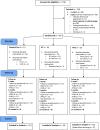Early Video-assisted Thoracoscopic Surgery or Intrapleural Enzyme Therapy in Pleural Infection: A Feasibility Randomized Controlled Trial. The Third Multicenter Intrapleural Sepsis Trial-MIST-3
- PMID: 37820359
- PMCID: PMC10765402
- DOI: 10.1164/rccm.202305-0854OC
Early Video-assisted Thoracoscopic Surgery or Intrapleural Enzyme Therapy in Pleural Infection: A Feasibility Randomized Controlled Trial. The Third Multicenter Intrapleural Sepsis Trial-MIST-3
Abstract
Rationale: Assessing the early use of video-assisted thoracoscopic surgery (VATS) or intrapleural enzyme therapy (IET) in pleural infection requires a phase III randomized controlled trial (RCT). Objectives: To establish the feasibility of randomization in a surgery-versus-nonsurgery trial as well as the key outcome measures that are important to identify relevant patient-centered outcomes in a subsequent RCT. Methods: The MIST-3 (third Multicenter Intrapleural Sepsis Trial) was a prospective multicenter RCT involving eight U.K. centers combining on-site and off-site surgical services. The study enrolled all patients with a confirmed diagnosis of pleural infection and randomized those with ongoing pleural sepsis after an initial period (as long as 24 h) of standard care to one of three treatment arms: continued standard care, early IET, or a surgical opinion with regard to early VATS. The primary outcome was feasibility based on >50% of eligible patients being successfully randomized, >95% of randomized participants retained to discharge, and >80% of randomized participants retained to 2 weeks of follow-up. The analysis was performed per intention to treat. Measurements and Main Results: Of 97 eligible patients, 60 (62%) were randomized, with 100% retained to discharge and 84% retained to 2 weeks. Baseline demographic, clinical, and microbiological characteristics of the patients were similar across groups. Median times to intervention were 1.0 and 3.5 days in the IET and surgery groups, respectively (P = 0.02). Despite the difference in time to intervention, length of stay (from randomization to discharge) was similar in both intervention arms (7 d) compared with standard care (10 d) (P = 0.70). There were no significant intergroup differences in 2-month readmission and further intervention, although the study was not adequately powered for this outcome. Compared with VATS, IET demonstrated a larger improvement in mean EuroQol five-dimension health utility index (five-level edition) from baseline (0.35) to 2 months (0.83) (P = 0.023). One serious adverse event was reported in the VATS arm. Conclusions: This is the first multicenter RCT of early IET versus early surgery in pleural infection. Despite the logistical challenges posed by the coronavirus disease (COVID-19) pandemic, the study met its predefined feasibility criteria, demonstrated potential shortening of length of stay with early surgery, and signals toward earlier resolution of pain and a shortened recovery with IET. The study findings suggest that a definitive phase III study is feasible but highlights important considerations and significant modifications to the design that would be required to adequately assess optimal initial management in pleural infection.The trial was registered on ISRCTN (number 18,192,121).
Keywords: intrapleural; pleural effusion; pleural empyema; randomized controlled trial; video-assisted thoracic surgery.
Figures


Comment in
-
Seeing through the MIST: A Pathway Toward Optimal Intervention for Pleural Infection.Am J Respir Crit Care Med. 2023 Dec 15;208(12):1261-1263. doi: 10.1164/rccm.202310-1822ED. Am J Respir Crit Care Med. 2023. PMID: 37934466 Free PMC article. No abstract available.
References
-
- Mummadi SR, Stoller JK, Lopez R, Kailasam K, Gillespie CT, Hahn PY. Epidemiology of adult pleural disease in the United States. Chest . 2021;160:1534–1551. - PubMed
-
- Bobbio A, Bouam S, Frenkiel J, Zarca K, Fournel L, Canny E, et al. Epidemiology and prognostic factors of pleural empyema. Thorax . 2021;76:1117–1123. - PubMed
Publication types
MeSH terms
Grants and funding
LinkOut - more resources
Full Text Sources
Medical
Miscellaneous

